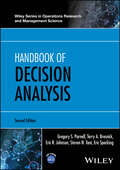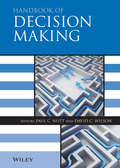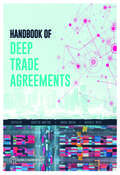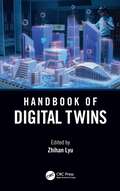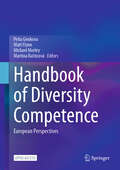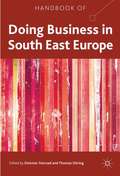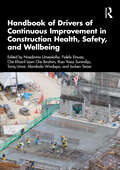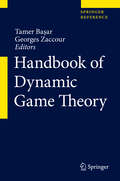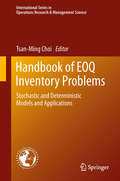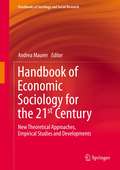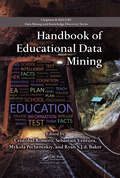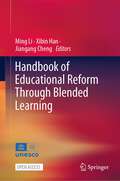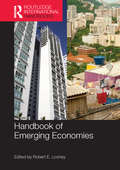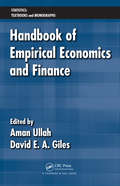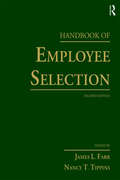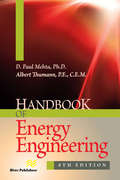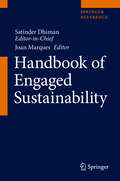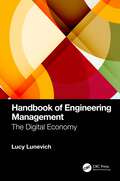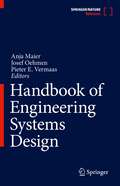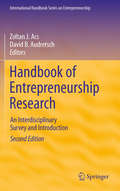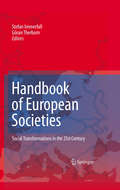- Table View
- List View
Handbook of Decision Analysis (Wiley Series in Operations Research and Management Science)
by Gregory S. Parnell Eric R. Johnson Steven N. Tani Terry A. Bresnick Eric SpeckingQualitative and quantitative techniques to apply decision analysis to real-world decision problems, supported by sound mathematics, best practices, soft skills, and more With substantive illustrations based on the authors’ personal experiences throughout, Handbook of Decision Analysis describes the philosophy, knowledge, science, and art of decision analysis. Key insights from decision analysis applications and behavioral decision analysis research are presented, and numerous decision analysis textbooks, technical books, and research papers are referenced for comprehensive coverage. This book does not introduce new decision analysis mathematical theory, but rather ensures the reader can understand and use the most common mathematics and best practices, allowing them to apply rigorous decision analysis with confidence. The material is supported by examples and solution steps using Microsoft Excel and includes many challenging real-world problems. Given the increase in the availability of data due to the development of products that deliver huge amounts of data, and the development of data science techniques and academic programs, a new theme of this Second Edition is the use of decision analysis techniques with big data and data analytics. Written by a team of highly qualified professionals and academics, Handbook of Decision Analysis includes information on: Behavioral decision-making insights, decision framing opportunities, collaboration with stakeholders, information assessment, and decision analysis modeling techniques Principles of value creation through designing alternatives, clear value/risk tradeoffs, and decision implementation Qualitative and quantitative techniques for each key decision analysis task, as opposed to presenting one technique for all decisions. Stakeholder analysis, decision hierarchies, and influence diagrams to frame descriptive, predictive, and prescriptive analytics decision problems to ensure implementation success Handbook of Decision Analysis is a highly valuable textbook, reference, and/or refresher for students and decision professionals in business, management science, engineering, engineering management, operations management, mathematics, and statistics who want to increase the breadth and depth of their technical and soft skills for success when faced with a professional or personal decision.
Handbook of Decision Making
by Paul C. Nutt David C. WilsonWiley's new Handbook of Decision Making is a vital reference text for all students and professionals of management, organization and decision making. The handbook offers a wide range of theoretical and empirical approaches to the understanding of organizational and strategic decisions. Contributors are internationally known experts drawn from North America, Canada and Europe who have spent many years in the study of decision making, and decision making relevant topics. We believe the handbook will become a tour de force in the understanding decision making, offering a wide variety of perspectives, topics, and summative understanding of the field. Chapters in the Handbook were prepared by the leading experts in their field and include cutting edge empirical, theoretical, and review chapters. The chapters bring together for the first time a critical mass of writing on decision making as an organizational and research activity. The Editors are two of the leading international experts in decision making and contribute to the Handbook with five original Chapters that offer an appraisal of the field and suggestions for research, as well as the current status of decision making practice and suggestion for improvement.
Handbook of Deep Trade Agreements
by Aaditya Mattoo, Nadia Rocha, and Michele RutaDeep trade agreements (DTAs) cover not just trade but additional policy areas, such as international flows of investment and labor and the protection of intellectual property rights and the environment. Their goal is integration beyond trade or deep integration. These agreements matter for economic development. Their rules influence how countries (and hence, the people and firms that live and operate within them) transact, invest, work, and ultimately, develop. Trade and investment regimes determine the extent of economic integration, competition rules affect economic efficiency, intellectual property rights matter for innovation, and environmental and labor rules contribute to environmental and social outcomes. This Handbook provides the tools and data needed to analyze these new dimensions of integration and to assess the content and consequences of DTAs. The Handbook and the accompanying database are the result of collaboration between experts in different policy areas from academia and other international organizations, including the International Trade Centre (ITC), Organisation for Economic Co-operation and Development (OECD), United Nations Conference on Trade and Development (UNCTAD), and World Trade Organization (WTO).
Handbook of Digital Twins
by Zhihan LyuOver the last two decades, Digital Twins (DTs) have become the intelligent representation of future development in industrial production and daily life. Consisting of over 50 chapters by more than 100 contributors, this comprehensive handbook explains the concept, architecture, design specification and application scenarios of DTs.As a virtual model of a process, product or service to pair the virtual and physical worlds, DTs allow data analysis and system monitoring by using simulations. The fast-growing technology has been widely studied and developed in recent years. Featured with centralization, integrity and dynamics, it is cost-effective to drive innovation and performance. Many fields saw the adaptation and implementation across industrial production, healthcare, smart city, transportation and logistics. World-famous enterprises such as Siemens, Tesla, ANSYS and General Electric have built smart factories and pioneered digital production, heading towards Industry 4.0.This book aims to provide an in-depth understanding and reference of DTs to technical personnel in the field, students and scholars of related majors, and general readers interested in intelligent industrial manufacturing.
Handbook of Diversity Competence: European Perspectives
by Michael Morley Petia Genkova Matt Flynn Martina RašticováThis open access handbook provides the most current overview of the discussion on diversity competence, with a focus on Europe. Diversity competence has become a key area of interdisciplinary study because of the increasingly intercultural nature of institutions and organisations across the world. This important handbook reviews the conceptual and theoretical foundations of this concept and reflects on the scope of its application. It provides directions for further research in the theory, research and practice of diversity competence and includes country-wise perspectives as well. An international team of researchers brings together insights from research and best practice in psychology, cultural sciences, economics, pedagogical sciences, sociology, social work, medicine, theology, politics and law. This is an important resource for a wide readership of students, researchers and practitioners who research on or work with people from diverse cultures.
Handbook of Doing Business in South East Europe
by Dietmar Sternad Thomas D�ringA comprehensive insight into a region which is characterized by rapid economic and social changes with a significant rise in foreign direct investments and privatization. Analysis covers political, legal, economic and social trends,and topics such as the influence of informal networks and corruption, as well as cultural diversity.
Handbook of Drivers of Continuous Improvement in Construction Health, Safety, and Wellbeing
by Riza Yosia Sunindijo Fidelis Emuze Che Khairil Izam Che Ibrahim Abimbola Windapo Nnedinma Umeokafor Tariq Umar Jochen TeizerThis Handbook presents opportunities, best practices, and case studies backed by cutting edge research on the drivers of continuous improvement of health, safety, and wellbeing in the architecture, engineering, construction, and facility management sector. The book consists of 23 chapters with six themes covering:● Drivers of the business case for healthier and safer construction● Opportunities and drivers of digital technologies for improving health and safety ● Drivers of human factors for improving health and safety● Drivers of safer design and procurement ● Drivers of better health and wellbeing for construction.● Opportunities for driving equality and inclusivity for safer construction.The book will be beneficial to academics, undergraduate and postgraduate (research and taught) students, professional institutions (such as the Institution of Occupational Safety and Health), health and safety professionals (health and safety officers, consultants and managers), occupational health professionals, mental health and wellbeing professionals, construction managers, architects, project professionals, engineers (design, construction, project, site, electrical, mechanical, civil, building services, and structural), facilities managers, quantity surveyors, and site managers. The aim of the book is to provide critical perspectives alongside evidence based practical examples of success stories, that should inspire readers and engender continuous improvement in health, safety, and wellbeing in the construction industry.
Handbook of Dynamic Game Theory
by Georges Zaccour Tamer BaşarThis will be a two-part handbook on Dynamic Game Theory and part of the Springer Reference program. Part I will be on the fundamentals and theory of dynamic games. It will serve as a quick reference and a source of detailed exposure to topics in dynamic games for a broad community of researchers, educators, practitioners, and students. Each topic will be covered in 2-3 chapters with one introducing basic theory and the other one or two covering recent advances and/or special topics. Part II will be on applications in fields such as economics, management science, engineering, biology, and the social sciences.
Handbook of EOQ Inventory Problems: Stochastic and Deterministic Models and Applications
by Tsan-Ming ChoiThe Economic Order Quantity (EOQ) inventory model first appeared in 1913, and in its centennial, it is still one of the most important inventory models. Despite the abundance of both classical and new research results, there was (until now) no comprehensive reference source that provides the state-of-the-art findings on both theoretical and applied research on the EOQ and its related models. This edited handbook puts together all these interesting works and the respective insights into an edited volume. The handbook contains papers which explore both the deterministic and the stochastic EOQ-model based problems and applications. It is organized into three parts: Part I presents three papers that provide an introduction and review of various EOQ related models. Part II includes four technical analyses on single-echelon EOQ-model based inventory problems. Part III consists of five papers on applications of the EOQ model for multi-echelon supply chain inventory analysis.
Handbook of EU Competition Law
by Walter FrenzThis handbook offers detailed descriptions of EU competition law, including mergers and public authorities. Above all, it analyzes and discusses recent decisions of the ECJ and the General Court. Presenting systematically structured and theoretically founded content, the book also includes recommendations for practitioners. Special attention is paid to the scope of penalties and the influence on fundamental rights. Rounding out the book, the conflict between safeguarding confidential information and the effectiveness of private and public enforcement is discussed intensively in the context of the new Directive 2014/104/EU.
Handbook of East Asian Entrepreneurship
by Fu-Lai Tony Yu and Ho-Don YanWith the shift of the global economic gravity toward emerging economies and the roaring economic growth of the past three decades in China, East Asian catching-up growth strategies have profound implications for latecomer economies. While there are many handbooks on entrepreneurship in general, there is no reference on East Asian entrepreneurship. This is the first of its kinds in the market. The volume provides a useful reference for those who want to know East Asian entrepreneurship and business systems. It also provides many excellent cases and illustrations on the growth of entrepreneurial firms and the rise of branded products in East Asia. Policy makers or scholars who are interested in entrepreneurship, small and medium sized enterprises, Asian business systems, international business, innovation and technology management, economic development, strategic management and East Asian studies would benefit from this volume. The volume contains two parts. The first part is the key concepts associate with entrepreneurship and East Asian firm growth and transformation. The second part presents cases of entrepreneurial firms and their founders in East Asia, including Japan, South Korea, Taiwan, Hong Kong and China. With the handbook, scholars, students and policy makers can grab some basic ideas how entrepreneurs and firms in East Asia compete and survive in the world market and understand why and how East Asia economies can emerge as one of the most dynamic regions in the world. Part I concepts: relating to Entrepreneurship: Guanxi Catching-up strategies Types of entrepreneurship Business System Strategic Management Leadership Part II cases cover variedly from manufacturing to services industries, and specifically including traditional and newly corporations ranging from toys, convenient stores, fast fashion, high-tech, to catering and service. Written by experts in their respective areas, Handbook of East Asia entrepreneurship is an excellent review of theories, policies and empirical evidences on important topics in Entrepreneurship in East Asian economic development. The book is both a superb teaching tool and a valuable handbook in development economics.
Handbook of Economic Sociology for the 21st Century: New Theoretical Approaches, Empirical Studies and Developments (Handbooks of Sociology and Social Research)
by Andrea MaurerThis handbook provides an overview on major developments that occurred in the field of economic sociology after its rebirth since the 1980s in the US. It offers new insights on the uniqueness of European economic sociology compared to US economic sociology which emerged at the end of the 20th century. The handbook presents economic sociology as a developing field which started with certain foundations as new economic sociology, widening the perspective by introducing social factors thereby focusing more on general belief systems, social forms of coordination and the relationships between society and the economy. It offers an outstanding portrait of the research field helping to identify major foundations and trajectories as well as new research perspectives for a globalized economic sociology. This makes the handbook appeal to specialized researchers of the field, researchers from other disciplines interested in economic phenomena, as well as graduate and postgraduate students.
Handbook of Educational Data Mining (Chapman & Hall/CRC Data Mining and Knowledge Discovery Series)
by Mykola Pechenizkiy Sebastian Ventura Cristóbal Romero Ryan S.J.d. BakerHandbook of Educational Data Mining (EDM) provides a thorough overview of the current state of knowledge in this area. The first part of the book includes nine surveys and tutorials on the principal data mining techniques that have been applied in education. The second part presents a set of 25 case studies that give a rich overview of the problems
Handbook of Educational Reform Through Blended Learning
by Ming Li Xibin Han Jiangang ChengThis open access book provides related theories, methods, strategies, and practical cases for implementing education reform through blended learning in curriculum, program, and institutions in the digital age. It sums up the research and practice achievements of blended learning from different research teams, involving more than 20 experts from educational technology, higher education, vocational education, and education management over the past 20 years.This book recommends relevant policies of blended learning to international organizations and governments in various countries, provides systematic solutions for administrators in institutions to promote educational reform via blended learning, and serves as a reference book for instructors, researchers, and relevant enterprise practitioners.
Handbook of Emerging Economies (Routledge International Handbooks Ser.)
by Robert E. LooneyA major new volume in the Routledge International Handbooks series analysing emerging and newly emerged economies, including the BRICS countries (Brazil, Russia, India, China and South Africa) and other likely (Turkey, Indonesia, Mexico, and South Korea) as well as possible (Vietnam, The Philippines, Nigeria, Pakistan, Egypt, Colombia and Argentina) candidates for emerging economy status. Chapters on theories surrounding emerging markets (including the Beijing/Washington Consensus debate) offer an overview of current issues in development economics, in addition to providing an integrated framework for the country case studies. Written by experts, this handbook will be invaluable to academics and students of economics and emerging economies, as well as to business people and researchers seeking information on economic development and the accelerating pace of globalization.
Handbook of Empirical Economics and Finance (Statistics: A Series of Textbooks and Monographs)
by Aman Ullah David E. A. GilesHandbook of Empirical Economics and Finance explores the latest developments in the analysis and modeling of economic and financial data. Well-recognized econometric experts discuss the rapidly growing research in economics and finance and offer insight on the future direction of these fields.Focusing on micro models, the first group of chapters de
Handbook of Employee Selection
by James L. Farr Nancy T. TippinsThis second edition of the Handbook of Employee Selection has been revised and updated throughout to reflect current thinking on the state of science and practice in employee selection. In this volume, a diverse group of recognized scholars inside and outside the United States balance theory, research, and practice, often taking a global perspective. Divided into eight parts, chapters cover issues associated with measurement, such as validity and reliability, as well as practical concerns around the development of appropriate selection procedures and implementation of selection programs. Several chapters discuss the measurement of various constructs commonly used as predictors, and other chapters confront criterion measures that are used in test validation. Additional sections include chapters that focus on ethical and legal concerns and testing for certain types of jobs (e.g., blue collar jobs). The second edition features a new section on technology and employee selection. The Handbook of Employee Selection, Second Edition provides an indispensable reference for scholars, researchers, graduate students, and professionals in industrial and organizational psychology, human resource management, and related fields.
Handbook of Energy Engineering (Energy Engineering and Systems)
by Albert Thumann D. Paul MehtaWith new chapters on electrical system optimization and ISO 50001, this edition also covers the latest updates to codes and standards in the energy industry. Also included are chapters on energy economic analysis, energy auditing, waste heat recovery, utility system optimization, HVAC, cogeneration, control systems, energy management, compressed air system optimization and financing energy projects. Additional topics include emerging technologies such as oxy-fuel combustion, high efficiency burners, enhanced heat exchangers, and ceramic membranes for heat recovery as well as information on how to do an energy analysis of any system; electrical system optimization; state-of-the-art lighting and lighting controls. This reference will guide you step by step in applying the principles of energy engineering and management to the design of electrical, HVAC, utility, process and building systems for both new design and retrofit projects. The text is thoroughly illustrated with tables, graphs, diagrams and sample problems.
Handbook of Energy Governance in Europe
by Michèle Knodt Jörg KemmerzellThis Handbook provides the most comprehensive account of energy governance in Europe, examining both energy governance at the European level and the development of energy policy in 30 European countries. Authored by leading scholars, the first part of the book offers a broad overview of the topics of energy research, including theories of energy transitions, strategies and norms of energy policy, governance instruments in the field, and challenges of energy governance. In the second part, it examines the internal and external dimensions of energy governance in the European Union. The third part presents in-depth country studies, which investigate national trajectories of energy policy, including an analysis of the policy instruments and coordination mechanisms for energy transitions. It closes with a comparative analysis of national energy governance. This book is a definitive resource for scholars in energy and climate research as well as decision makers in national governments and EU institutions.
Handbook of Engaged Sustainability
by Satinder Dhiman Joan MarquesThis handbook is based on the premise that in order for sustainability to be sustainable, a profound psychological transformation has to take place at the individual and collective level. Focusing on the practice of environmental sustainability, this handbook will explore the application of sustainability in a wide variety of contemporary contexts—from economics of consumption and growth to government policy, sustainable cities, and sustainable planet. The editors believe that the way to achieve sustainable, harmonious living in all spheres is through lived or engaged sustainability at the personal, team, and organizational levels. It is impossible to separate economic development issues from environment issues. In its most practical aspect, sustainability is about understanding the interconnections among environment, society, and economy. This book aims to provide a comprehensive overview of current theories and approaches in the area of engaged sustainability for academics, researchers and practitioners. Specifically, it will focus on making responsible decisions that will reduce humanity’s negative impact on the environment. While various social and political initiatives for sustainability are welcome, one cannot really enact sustainability into legislative laws. Something has to change fundamentally at the level of a common person in the street. The Handbook of Engaged Sustainability acknowledges the classic literature, theories and principles in the area of sustainability, but also provides new theories and approaches from global scholars and practitioners in the field. It will also provide a well-structured pedagogical framework with real life case examples. The aim of this handbook is to expand the reader’s thinking to one of “big-picture awareness” and a “cosmic vision” of sustainability, a vision that extends from our neighborhoods to our communities, to states, countries, globe, galaxy, and envelops the entire Universe! This book will serve as an essential resource for researchers, scholars and students of sustainability, ethics, corporate social responsibility and environmental economics, as well as consultants, business and team leaders, and anyone interested in engaged sustainability.
Handbook of Engineering Management: The Digital Economy
by Lucy LunevichThe Engineering Management discipline remains complex and multidisciplinary, and has progressed and broadened in scope significantly over the last 10–20 years. Previously, the discipline has been fragmented and not aligned with the purposes of economic development, mega-project delivery, and technological progress. Digital engineering has revolutionized the field of engineering by introducing digital tools and technologies to the design, creation, operation, and maintenance of physical systems, products, and services. It has enabled more efficient, effective, and sustainable solutions, and has the potential to drive significant innovation and improve the way we design, build, and operate physical systems. This handbook addresses new content of complexity by offering new engineering concepts such as simple, complicated, and complex, which have never been included in this discipline before and will generate interest from higher education, financial institutions, and technology companies. Handbook of Engineering Management: The Digital Economy focuses on multidisciplinary integration and complex evolving systems. It discusses the incorporation of a system of systems along with engineering economic strategies for sustainable economic growth. This handbook highlights functional leadership as the main part of an engineering manager’s competency and discusses how to form alliances strategically. In addition, it presents a comprehensive guide for the implementation of an environmental management system and shows how environmental and social impacts can be assessed in an organization applying digital tools. This handbook also brings together the three important areas of Engineering Management: Knowledge Management, the Digital Economy, and Digital Manufacturing. In addition, this handbook provides a comprehensive guide to implementing an environmental management system and shows how environmental and social impacts in an organization can be assessed using digital tools. Based on the authors’ practical experience, it describes various management approaches and explains how such a system can be used to prioritize actions and resources, increase efficiency, minimize costs, and lead to better, more informed decision making. It is essential to follow a systematic approach and to ask the right questions, whether the system is managed and implemented by humans, AI, or a combination of both. This handbook is laid out in a series of simple steps and dispels the jargon and myths surrounding this important management tool. This handbook is an ideal read for engineering managers, project managers, industrial and systems engineers, supply chain engineers, professionals who want to advance their knowledge, and graduate students.
Handbook of Engineering Systems Design
by Pieter E. Vermaas Anja Maier Josef OehmenThis handbook charts the new engineering paradigm of engineering systems. It brings together contributions from leading thinkers in the field and discusses the design, management and enabling policy of engineering systems. It contains explorations of core themes including technical and (socio-) organisational complexity, human behaviour and uncertainty. The text includes chapters on the education of future engineers, the way in which interventions can be designed, and presents a look to the future. This book follows the emergence of engineering systems, a new engineering paradigm that will help solve truly global challenges. This global approach is characterised by complex sociotechnical systems that are now co-dependent and highly integrated both functionally and technically as well as by a realisation that we all share the same: climate, natural resources, a highly integrated economical system and a responsibility for global sustainability goals. The new paradigm and approach requires the (re)designing of engineering systems that take into account the shifting dynamics of human behaviour, the influence of global stakeholders, and the need for system integration. The text is a reference point for scholars, engineers and policy leaders who are interested in broadening their current perspective on engineering systems design and in devising interventions to help shape societal futures.
Handbook of Entrepreneurship Research
by Zoltan J. Acs David B. AudretschInterest in and attention to entrepreneurship has exploded in recent years. Nevertheless, much of the research and scholarship in entrepreneurship has remained elusive to academics, policymakers and other researchers, in large part because the field is informed by a broad spectrum of disciplines, including management, finance, economics, policy, sociology, and psychology, often pursued in isolation from each other. Since its original publication in 2003, the Handbook of Entrepreneurship Research has served as the definitive resource in the field, bringing together contributions from leading scholars in these disciplines to present a holistic, multi-dimensional approach. This new edition, fully revised and updated, and including several new chapters, covers all of the primary topics in entrepreneurship, including entrepreneurial behavior, risk and opportunity recognition, equity financing, business culture and strategy, innovation, and the impact of entrepreneurship on economic growth and development. Featuring an integrative introduction, extensive literature reviews and reference lists, the Handbook will continue to serve as a roadmap to the rapidly evolving and dynamic field of entrepreneurship.
Handbook of Environmentally Conscious Manufacturing
by Christian N. MaduManufacturers, under pressure from their major stakeholders, integrate environmental issues in the design and management of their products. These stakeholders include customers, regulators, employees, communities, and interest groups who have a common stake in protecting the earth from pollution and in limiting the exploitation of earth's limited natural resources. Manufacturers recognize that being environmentally responsible also offers competitive advantage to the firm. The Handbook of Environmentally Conscious Manufacturing is written as a state-of-the-art reference to guide environmentally conscious manufacturing (ECM). All the contributors have done extensive research and/or practice work in the field of ECM. The Handbook covers all the major topics in Environmentally Conscious Manufacturing. There are specific chapters to deal with sustainable manufacturing, recycling, eco-labelling, life cycle assessment, and ISO 14000 series of standards, as well as decision-making aspects of Environmentally Conscious Manufacturing. Decision-oriented topics on supply chain, decision models, quality initiative, environmental costing and decision support systems are also covered. The influence of ECM on marketing imperative is also covered.
Handbook of European Societies
by Göran Therborn Stefan ImmerfallEuropean integration is one of the most ambitious and socially far-reaching developments in world politics and in world economics. Against growing opposition and despite increasing social heterogeneity, the European Union continues to expand and to acquire new competences. But to what extent is the self-proclaimed "ever closer union among the peoples of Europe" a social reality? In which ways is the political European project anchored in social developments? How does social change impinge upon political integration? Societal trends in multi-cultural, multi-ethnic, multi-lingual and socially diverse Europe have never been studied systematically. Handbook of European Societies: Social Transformations in the 21st Century sets to rectify this neglect of societal developments in Europe, providing a groundwork for the sociology of European integration. The book portrays social life and social relations in the enlarged Europe, and gives a perspective on the European Union as an evolving social entity. Handbook of European Societies is a pioneering source book analyzing the current social patterns on the continent. It covers a representative selection of major topics of social concern and sociological relevance, such as Collective Action, Consumption, Identity, Power Structure, Sexuality, Stratification and Well-being. Each contribution probes key developments in a strictly comparative manner. The Handbook thus offers a detailed look into the intricacies of the national societies of Europe and into the prospect of an emerging European society. The Editors have enlisted leading researchers to synthesize existing knowledge and to make use of many different data sources in a straight-forward style. The contributions stay away from jargon, simple labeling and sweeping assertions. Instead, they provide solid and accessible information on a wide variety of social trends and processes within and across European societies.
